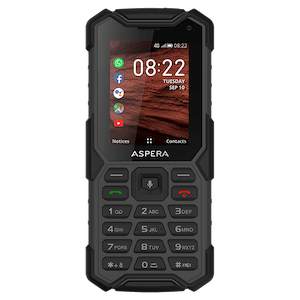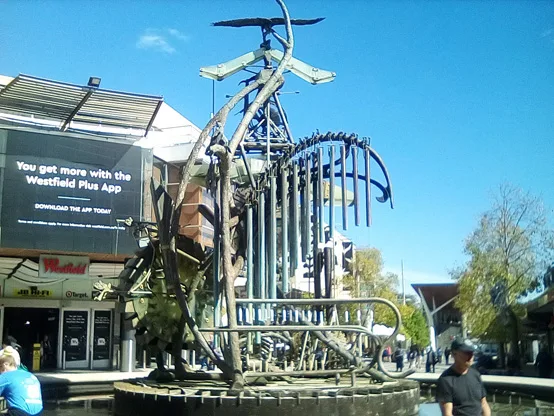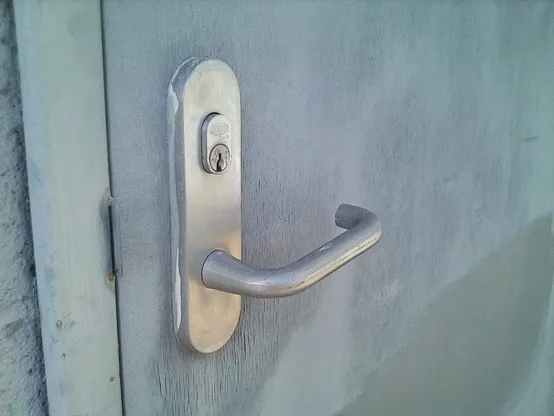Aspera R40 Review: Tough, cheap and familiar
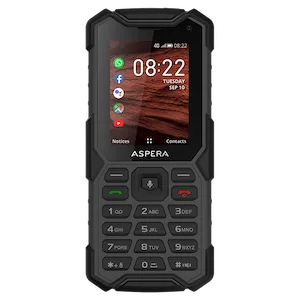
-
- Battery Score
4
- Camera Score
2
- Design Score
4.5
- Performance Score
3.5
- Battery Score
4
Summary
Quick verdict: The Aspera R40 takes the tough feature phone challenge laid down by the Nokia 800 Tough and delivers a very similar product at a much cheaper price point.
- IP68 water resistant
- Large, friendly buttons
- KaiOS has some extensibility
- Removable battery
- Not quite as rugged as the Nokia 800 Tough
- Limited in the classic feature phone ways
- Camera is awful
Details
Pricing & Availability
| RRP | $158 |
| Launch date | 2019-04 |
When I first unpacked the Aspera R40, I couldn't help but feel as though I'd seen something like it before. Feature phones are naturally nothing new, but ruggedised feature phones are something more of a rarity.
Could it be simply that I was reminded of Aspera's most recent rugged phone, the Aspera R9? No, it wasn't that, because the Aspera R40 is a low cost rugged feature phone, where the Aspera R9 is an Android smartphone.
Then it struck me; the Aspera R40 is a very close clone, or at least a not-too-distant-relative, design-wise to the excellent Nokia 800 Tough.
That's an intriguing concept, because while feature phones aren't for everyone, the Nokia 800 Tough remains one of my favourites thanks to that damned near indestructible design.
The Aspera R40 is significantly cheaper than the Nokia 800 Tough's asking price, and while that does bring with it a few small compromises, it's easily Aspera's best feature handset to date, even if you don't think you need a rugged feature phone.
Design
Design
- 2.4-inch low resolution display
- Large rubber buttons
- Industrial design
- It's tough – but how tough?
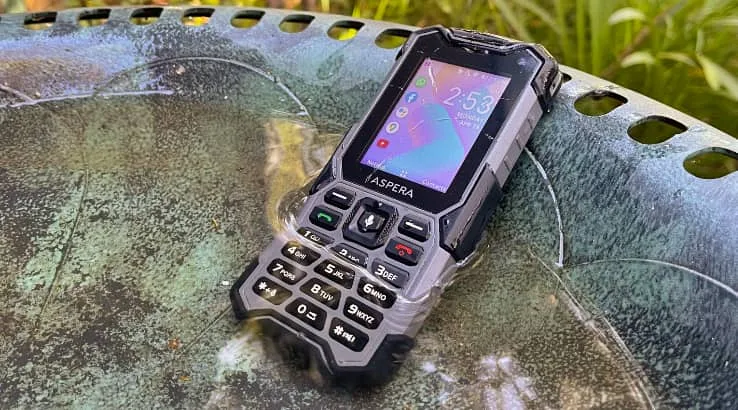
The reason why the Aspera R40 reminded me of the older Nokia phone so much is because from a design perspective, they're very similar devices. Both use a strong industrial design ethic to give you the idea that they might be rugged phones. Both use the same 2.4-inch QVGA (320x240) panel for displaying limited quantities of information.
However, there are differences. The Aspera R40 doesn't offer the carabiner loop of the Nokia 800 Tough, and it only comes in a single colour where Nokia offered colour choices.
What you do get that wasn't a function of the Nokia 800 Tough at all is a removable battery. To keep matters secure this isn't something that you can easily pop in and out of place, with multiple screws that need to be turned to take the back section off for battery, SIM and microSD expansion purposes.
This gets to the meat of the Aspera R40's value proposition, because like the Nokia 800 Tough, it's a hardened handset designed for more precarious working environments, or possibly just for those of us best described as "terminally clumsy".
To that end, the Aspera R40 is IP68 rated for water immersion of up to 1m for 30 minutes, and is fully dust resistant. The body is wrapped in rubber shock-absorbent bumpers, and the display screen is recessed to give it a little further protection. All of these are great inclusions if you want a low-cost tough phone, but it's worth noting that Aspera's take doesn't quite carry the same qualifications as the very similar Nokia phone. The Nokia 800 Tough is MIL-STD-810G compliant, and Nokia qualifies that it's capable of surviving drops of up to 1.8m onto concrete.
Aspera doesn't quite make the same claims, just some vague statements about it being "truly rugged". It may well be that it simply didn't seek those specific qualifications for its very similar handset. I'd really need a number of both phones, some hammers and some destructive testing time to tell for sure, but on paper, while the Aspera R40 is tough, the Nokia 800 Tough is probably tougher.
Camera
Camera
- 2MP rear camera is there, but it's poor
- Front-facing selfie camera is worse
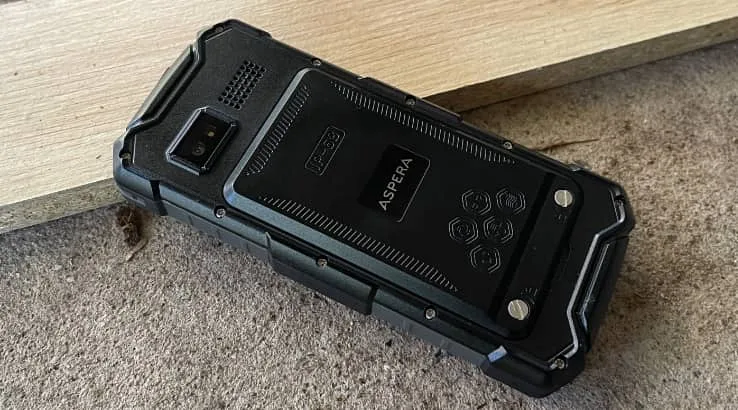
One area where Aspera technically outdoes Nokia with the Aspera R40 is in the camera space. Both phones feature a 2MP rear camera, but Aspera's model also includes a front-facing selfie camera module as well.
Don't get too excited though, because the front-facing camera on the Aspera R40 has a 0.3MP sensor. I'd call the results poor, but that would be unfair to the word poor, really.

I know I'm getting on in years, but my face isn't that grainy just yet.
It's not much of a better story when you switch to the 2MP rear camera either. The camera app only has modes for still and video shooting, and it's slow to focus and doesn't even particularly manage good shots in decent light.
If you only ever look at them on the Aspera R40's 320x240 screen they might just look passable, but put them onto any other device and the noise and colour flaws become all too apparent.
This is all very much par for the course for this kind of feature phone. We're yet to see anyone put a good sensor onto a feature phone, and given their niche status in 2021, it seems like a long shot that anyone would bother.
Performance
Performance
- KaiOS covers the basics in a basic way
- Google Assistant is preferable to T9 text entry
- Did we mention it's tough?
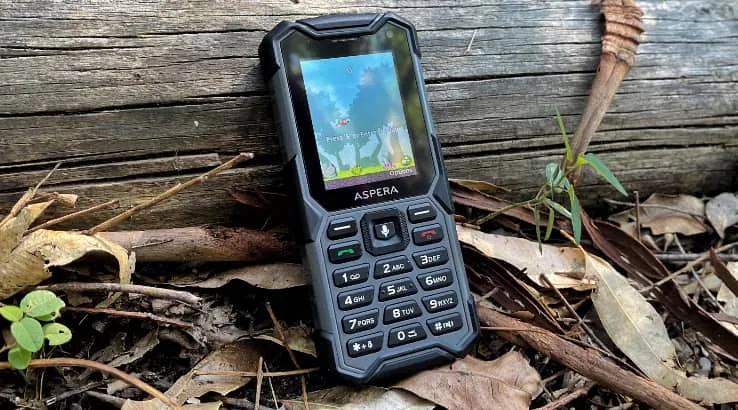
The base specifications of the Aspera R40 are, like so many feature phones, incredibly simple. It runs off a MediaTek 6731 1.1Ghz processor with just 512MB of RAM and 4GB of onboard storage, expandable via microSD. Most of that space is taken up with the operating system and apps, but then it doesn't feel like too much of a stretch to suggest that feature phone owners aren't likely to want to store a lot of apps or data on their feature phones anyway.
The Aspera R40 uses the open source KaiOS as its core operating system which is (surprise!) exactly what the Nokia 800 Tough did as well. KaiOS is a Linux-based operating system explicitly designed for very low power keypad phones with a kind of fascinating history for the nerdy types like myself. It's sort-of-kind-of-technically the successor to those Firefox phones that Mozilla tried to make popular back in 2013.
KaiOS incorporates a number of preinstalled Google features, and in some ways you could view it as somewhat like a super light version of Android. For what it's worth, if you plug the Aspera R40 into a Mac running the Android File Transfer client, it'll treat it exactly as if it were an Android phone.
Still, it's a simple feature phone designed more for folks who want calling and texting abilities. You do get preinstalled Facebook, WhatsApp, Google Maps and YouTube apps, as well as integrated Google Assistant, which is way handier than you might think.
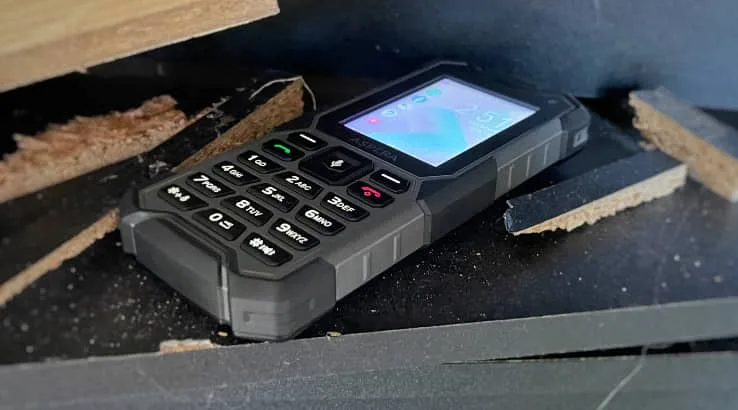
That's because like every other keypad phone, you're otherwise stuck with T9 predictive text. Back in the day it was popular because it was all we had, but in a smartphone age with swipe-capable touch keyboards, it feels incredibly archaic and slow. Yes, you can surf the web on the Aspera R40's tiny screen, but simply entering a URL that way is a serious commitment of minutes of your time. Telling Google Assistant to do it is considerably faster.
You even get games, although fans of Snake will be disappointed to note that it's not present. That's a Nokia exclusive, just as it was back in the day, but you do get knockoff versions of Flappy Bird, Bejewelled and Threes/2048 to while away a few spare minutes if you wish. KaiOS even has its own app store to extend the functionality of the Aspera R40. Don't expect the array of apps you'd get on an iPhone or Android handset, however, with a much more limited array of games, social apps and educational apps on offer.
The other performance area of the Aspera R40 worth testing is naturally its toughness. Like the Nokia 800 Tough, I didn't have an array of R40s to test to the point of destruction, so I could only go off the single unit I had. More than a few games of "throw the R40 down the stairs" and "drop the R40 onto the driveway" ensued, and outside a few scuffs it passed the test nicely. Likewise, I filled my birdbath with water – because our avian friends need hydration – and dropped the Aspera R40 in for immersion purposes.
I learned two key facts this way. Firstly, the Aspera R40 is indeed water resistant for most likely splash and dunking scenarios. Secondly, even cockatoos won't attempt to drink the Aspera R40.
Again, without a Nokia 800 Tough, some time and some malice to hand, I can't say that it's indestructible or better than Nokia's effort, but for most folks actively not seeking to destroy a handset the Aspera R40 should certainly be tough enough, if not in fact the toughest phone you can buy.
Battery life
Battery life
- 2,500mAh removable battery
- Fine for a day or two's usage, but not the best
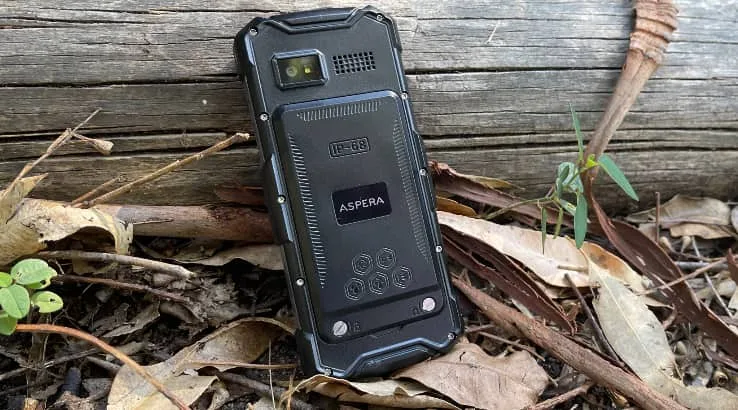
The Aspera R40 runs off a 2,500mAh removable battery, although as previously noted it's not a battery that's particularly easy to remove if you wanted to swap it out, and that's by design. Charging is via microUSB, and while that's a tad annoying in a year where we're finally seeing budget Android phone makers adopt USB C, it's not entirely surprising.
It's also not particularly fast, but for this market segment that's also to be expected. Most users are likely to adopt the overnight charging regime, and that'll work just fine for several days of usage.
Again, the contrast to the Nokia 800 Tough is a notable one, because Nokia rates its phone as good for up to 34 standby days on a 2,100mAh battery, while Aspera only reckons on 15 days of standby. The Aspera R40 managed fairly well during my test time, but I'd be lying if I said I made it my day-to-day phone – I'm very much the smartphone audience, not the feature phone one – so it did more standby than actual usage in my tests.
Still, that was true for the Nokia 800 Tough, and despite having a smaller battery, it tended to last just a little longer. The Aspera R40 doesn't have bad battery life for a feature phone, and most users are likely to only use it sparingly anyway, so this is again well within what you'd expect, and above the capabilities of just about any smartphone to boot.
Should you buy the Aspera R40?
- Buy it if you want a low-cost rugged feature phone.
- Don't buy it if you want the toughest feature phone.
Aspera as a brand sells itself on affordability rather than high-end features, but the Aspera R40 presents a fascinating balance. I do think I liked the Nokia 800 Tough just a little more in design and performance terms, but it's an awfully close-run matter, and I can't ignore the fact that the Aspera R40 is a substantially cheaper phone.
Most folks looking for a tough phone aren't going to deliberately abuse it; they're just after a handset that will be able to take more than a few of life's harder knocks. If that's you, and if you're after a feature phone specifically, the Aspera R40 delivers nicely.
Pricing and availability
Specifications
Display
Camera
Physical Dimensions
Connectivity
Power, storage and battery
Device features
Images: Alex Kidman
More Finder reviews
Alex Finder
Senior editor
You are about to post a question on finder.com.au:
- Do not enter personal information (eg. surname, phone number, bank details) as your question will be made public
- finder.com.au is a financial comparison and information service, not a bank or product provider
- We cannot provide you with personal advice or recommendations
- Your answer might already be waiting – check previous questions below to see if yours has already been asked
Finder only provides general advice and factual information, so consider your own circumstances, or seek advice before you decide to act on our content. By submitting a question, you're accepting our Terms Of Service and Finder Group Privacy & Cookies Policy.
This site is protected by reCAPTCHA and the Privacy Policy and Terms of Service apply.
